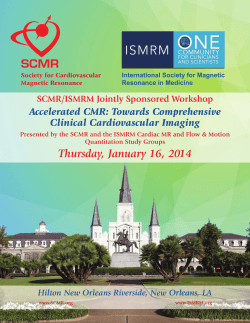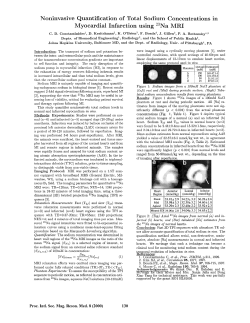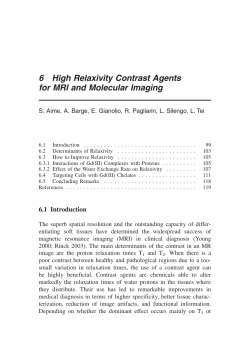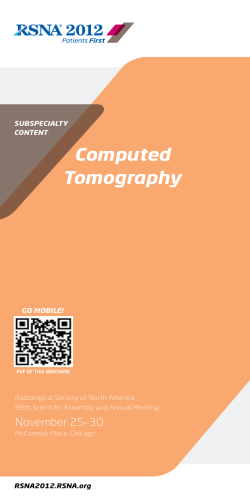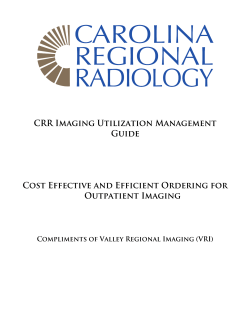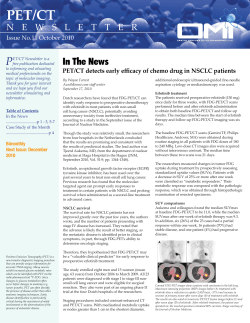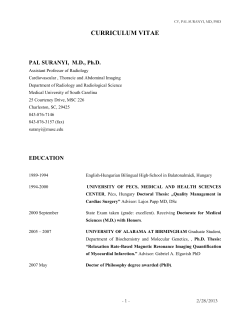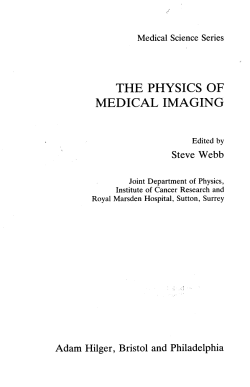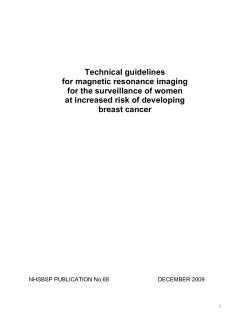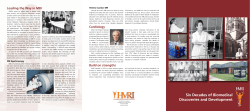
Brain Imaging Technologies and Their Applications in Neuroscience
Brain Imaging Technologies and Their Applications in Neuroscience By Carolyn Asbury, Ph.D. With appreciation to John A. Detre, M.D., Ulrich von Andrian, M.D., Ph.D., and Michael L. Dustin, Ph.D. for their expert guidance Section I Introduction Imaging is becoming an increasingly important tool in both research and clinical care. A range of imaging technologies now provide unprecedented sensitivity to visualization of brain structure and function from the level of individual molecules to the whole brain. Many imaging methods are noninvasive and allow dynamic processes to be monitored over time. Imaging is enabling researchers to identify neural networks involved in cognitive processes; understand disease pathways; recognize and diagnose diseases early, when they are most effectively treated; and determine how therapies work. Moreover, as in other areas of biomedical research, these opportunities are interactive. As an example, imaging can provide a better understanding about a disease process that leads to discovery of potential therapies that intervene in that process. Thereafter, imaging can help provide a better 1 understanding about how that drug or therapy works at the molecular level, leading to a more precise understanding of the disease process and then to development of a more highly specific drug to treat it. Different types of imaging are used to reveal brain structure (anatomy), physiology (functions), and biochemical actions of individual cells and of the molecules that compose them, and of cells’ functions, behaviors and interactions. The three main categories, therefore, are often referred to as structural, functional and molecular imaging. While many imaging techniques are used throughout the body, the descriptions provided here focus on their use in the nervous system, primarily the brain. Alone and in combination, these imaging techniques are transforming our understanding of how the brain functions, how immune cells function, and how immune cells interact with the brain in health and disease. Imaging’s Evolution: Early Structural Imaging Techniques While many structural and functional imaging techniques are relatively recent, the origin of structural imaging was the X-ray, developed in 1895. X-rays measure the density of tissues. X-rays use photons, a quantum of visible light that possesses energy; the photons are passed through the body and deflected and absorbed to different degrees by the person’s tissues. They are recorded as they pass out of the body onto a silver halide film. Dense structures such as bone, which block most of the photons, appear white; structures containing air 2 appear black; and muscle, fat and fluids appear in various shades of gray. This technology was the clinician’s main imaging tool for more than half of the 20th century. A related early technique was angiography, in which a radiopaque dye was injected through a catheter into a blood vessel to detect a blockage or narrowing or architecture of downstream vessels. The vessels were outlined on x-ray as white. Angiography was used to visualize arteries anywhere in the body, including the neck and brain. Computerization transformed the x-ray in the 1970s, with the development of Computer Assisted Tomography (CT), and its two main developers received the Nobel Prize in Medicine or Physiology in 1979. This technology uses special x-ray equipment to obtain three-dimensional anatomical images of bone, soft tissues and air in the entire body, including the head. An x-ray emitter is rotated around a patient. It measures the rays’ intensities from different angles. For brain imaging, numerous X-ray beams are passed through the head at different angles. Special sensors measure the amount of radiation that is absorbed by different tissues. Then, a computer uses the differences in X-ray absorption to form cross-sectional images or “slices” of brain called “tomograms.” CT imaging was the first technique, for instance, to show clear evidence, during life, of decreases in the amount of brain tissue in older compared to younger people. CT can be used with or without contrast agents (dyes, such as 3 iodine, that make structures easier to see), but use of contrast enables CT to show bone, soft tissues and blood vessels in the same images. Because CT can be done quickly, it is especially useful in emergency trauma situations, showing any abnormalities in brain structure including brain swelling, or bleeding arising from ruptured aneurysms, hemorrhagic stroke (a ruptured blood vessel), and head injury. Ultrasound, another early technique developed in the 1930’s-40’s, was primarily used neurologically until the 1960s to try to identify brain tumors. Ultrasound uses sound waves to determine the locations of surfaces within tissues, and differentiates surfaces from fluids. It does so by measuring the time that passes between the production of an ultrasonic pulse and the echo created when the surface reflects the pulse. But, when scientists determined that the skull significantly distorts the signals, its use for this purpose stopped while its use in obstetrics and gynecology—to image the fetus in utero and to detect ovarian tumors—became widespread. Fortuitously, abandonment of ultrasound to try to detect brain tumors came at the same time that new radiological technologies for brain imaging such as magnetic resonance imaging (MRI) were emerging. Beginning in the 1980s, however, new ultrasound techniques (“Laser Doppler Ultrasound”) began to evolve; these techniques employ laser technology to combine information from both light and sound and have become a vital part of intensive monitoring of cerebral blood flow in patients with severe head trauma. These 4 technologies and their uses are described later in the section on Electrical and Doppler Ultrasonic Imaging Techniques. Entrance of Physiological Imaging and Highly Sensitive Structural Imaging Physiological imaging techniques measure changes in cerebral blood flow (CBF) and brain metabolism. These measurements complement structural imaging studies by providing information on regional brain function either at rest or in response to specific perturbations and how it is altered by brain disorders. Positron Emission Tomography (PET) was the first major technology to measure physiological functioning in the brain. In PET scanning, the regional distribution of exogenously administered positron emitting tracers is measured using tomographic imaging. The first PET tracer to be used in humans was 18 F- deoxyglucose, which distributes according to regional glucose utilization. Because water is freely diffusible from the blood to the brain, 15 O-H2O provides a PET tracer for measuring cerebral blood flow, and was another early tracer used for measuring regional brain function. When introduced clinically in the 1970s, PET provided a fundamentally new opportunity to explore the parts of the brain that were activated in undertaking specific tasks, a role it dominated for more than a decade. This application of PET is predicated on the observation that changes in regional neural activity are coupled to changes in regional cerebral blood flow and 5 metabolism. More recently the main functions for PET are focused on the study of neurotransmitters (electrochemical signals passed from one brain cell to another to communicate), the actions of pharmaceutical drugs, and the expression of specific genes in the brain. Additionally, in recent years a few PET tracers have been developed that attach solely to the protein beta amyloid, which builds up in the brains of patients with mild cognitive impairment (MCI) and Alzheimer’s disease. PET imaging with these agents has the potential, along with cognitive tests, to diagnose Alzheimer’s disease in patients, and to identify patterns that may predict which patients with MCI will develop Alzheimer’s disease. Due to PET’s ability to measure tiny concentrations of the radioisotope tracer used, its measurements are exquisitely sensitive. But its utility— especially clinically—compared to its use in research, is compromised to some extent by the non-specific nature of the changes in CBF and metabolism and the need to actually make the radioisotopes at the clinical site. Radioisotopes, produced by huge and expensive cyclotrons, need to be made at the site because they decay quickly and so must be used soon after they are made. This rapid decay is referred to as having a short “half-life,” which is the time it takes for 50 percent of the radioactivity to decay. Because of the tiny amount of radioisotope used and its rapid decay, PET tracers generally produce no adverse effects in patients. The tracer is injected into a patient’s vein and travels to the brain. The positrons rapidly collide with electrons and release gamma rays oriented in opposite directions along exactly the same line. 6 These gamma rays are detected by two sensors simultaneously, enabling computers to precisely pinpoint the brain locations of interest. Due to the need for the expensive cyclotron at the clinical site and the subsequent development of alternative physiological imaging techniques, PET is not used extensively to study brain areas that are activated when undertaking a specific cognitive or motor task (“task activation” studies), Instead, one of its current major uses is in research on excitatory and inhibitory neurotransmitters (electrochemical messages passed from one brain cell to another to communicate). Each neurotransmitter, such as dopamine, GABA, serotonin and others, attaches to a specialized receptor on a brain cell that receives the message. In this way, PET identifies brain cell networks using a specific neurotransmitter to communicate, and also helps to see whether abnormally high or low transmitter levels are associated with specific brain conditions. As an example, Parkinson’s disease is characterized by low levels of the neurotransmitter dopamine. PET is used in Parkinson’s disease research primarily to assess the effects of experimental treatments on dopamine and to determine exactly how they work. Also, though not often used for this purpose, PET imaging of the dopamine network (dopaminergic system) can help to differentiate early stage Parkinson’s disease from other “parkinsonian” disorders (multiple system atrophy, progressive supranuclear palsy or Huntington’s disease). In the case of PET exploration of dopamine (as for other neurotransmitters), a radioisotope is attached to molecules that look like 7 dopamine and, when introduced intravenously into a person, are taken up by the same cells that take up dopamine. The radioisotopes make their way to the brain and concentrate there. PET then images the amount of the labeled molecules that has been taken up by brain cells to measure dopamine levels. Because PET tracers bind to many of the same receptors that pharmaceutical drugs bind to, PET is also widely used to study how pharmaceuticals act in the brain. Additionally, PET can repeatedly and quantitatively image gene expression (proteins produced by genes) in the brain, to provide new insights into the contributions of specific genes to brain disorders and diseases. More recently, a few specific PET tracers, such as PIB-PET (Pittsburgh Compound B”) and “florbetapir -F18 PET” have been developed that bind solely to beta amyloid proteins, which accumulate in the brains of people with presymptomatic mild cognitive impairment (MCI), overt MCI, and those with Alzheimer’s disease, but not in the brains of cognitively healthy adults. Importantly, not all people with presymptomatic or overt MCI go on to develop Alzheimer’s disease. Scientists may be able to identify the patterns that indicate which people with presymtomatic or overt MCI will go on to develop Alzheimer’s disease and which will not, by imaging all three groups of patients serially over several years. Because PIB-PET has an extremely short half-life of only 20 minutes, it is used for research only at academic centers. A Food and Drug administration 8 (FDA) advisory committee in early 2011 recommended that Florbetapir F-18, which has a relatively longer half-life than PIB-PET, be considered for FDA approval as the first generally available physiological diagnostic tool for Alzheimer’s disease, to be used in conjunction with cognitive tests. The committee advised that approval be contingent upon the manufacturer developing a training program for clinicians that successfully teaches them how to consistently read the scans accurately. An imaging technology that is similar to PET is Single Photon Emission Computed Tomography (SPECT). It is used for most of the same purposes as PET, but is less expensive and more convenient for clinical use. SPECT began to be widely employed clinically in the 1980s because, unlike PET, it detects directly emitted gamma-rays from commercially available stable radioisotopes. These isotopes are larger and have a longer half-life than those used in PET, but the imaging is less precise. So, patients who are seen in clinics other than at academic research institutions are far more likely to receive SPECT rather than PET scans. Like PET, however, many of its clinical functions have been taken over by other physiological imaging techniques, most notably Magnetic Resonance Imaging (MRI). Non-invasive Structural and Physiological Imaging: MRI Technologies Magnetic Resonance Imaging (MRI) is based on the principle of nuclear magnetic resonance and uses radiofrequency waves to probe tissue structure 9 and function without requiring exposure to ionizing radiation. The two researchers who made MRI clinically feasible in the 1980s by building on initial discoveries of the 1930s won the Nobel Prize in Physiology or Medicine in 2003. Clinically, MRI has become the most important diagnostic imaging modality in neuroscience. One of the many benefits of MRI in the central nervous system is that the radiofrequency signals readily penetrate the skull and spinal column, allowing the tissue within it to be images with no interference. MRI provides the best visualization of parenchymal abnormalities in the brain and spinal cord including tumors, demyelinating lesions, infections, vascular lesions such as stroke, developmental abnormalities, and traumatic injuries. There are numerous variations on MRI that are also in wide clinical use. These include flow-sensitive approaches termed magnetic resonance angiography and magnetic resonance venography that are used to detect stenosis (narrowing) or clotting of arteries and veins, diffusion sensitized MRI that can be used to detect acute strokes just minutes after their onset, and perfusion sensitized MRI that can demonstrate regional cerebral blood flow and blood volume. In addition to MRI’s uses in clinical care, functional MRI (fMRI) is used to identify specific brain areas involved in activation of motor and cognitive tasks, and to detect reorganization in the brain following injury to a localized area. 10 Most MRI techniques use signals from water, which constitutes about two-thirds of human body weight, to develop information on brain structures and functions. Protons (positively charged particles) in hydrogen molecules in water produce the signal when exposed to a strong magnetic field. The MRI machine contains the magnet. Structural MRI measures the nuclear magnetic resonance of water protons to create a computerized three-dimensional image of tissues. More specifically, protons in the nuclei of hydrogen atoms in water move (oscillate) between two points and vibrate when they are exposed to a strong magnetic field. They absorb energy in the frequency of radio waves; and then they remit this energy in the same radiofrequency (a process called resonance) when they return to their original state. MRI uses the body’s own molecules, while PET and SPECT require introduction of a radioactive label into the body with a drawback of exposure to low levels of ionizing radiation. Small differences in the protons’ oscillations are mathematically analyzed by computer to build a three-dimensional image of tissues. Variations that occur in the molecular environment of water located in different brain structures and compartments provide contrast, and the ability to see the spatial orientation of various brain structures. The molecular environment of water is also affected by disease processes. The contrast differentiates the brain’s gray matter (primarily nerve cell bodies) from white matter (primarily axons and their myelin sheaths) which are the nerve cell communication cables that connect brain regions. Structural MRI 11 undertaken serially over a two-year period, for instance, shows that the brain’s hippocampus (primarily gray matter) becomes progressively smaller (degenerates) in adults with Alzheimer’s compared to adults who are cognitively healthy. Functional MRI (fMRI) shows the brain in action; scientists use it extensively to elucidate processes involved in higher cognitive functioning. It is highly sensitive so it can detect small changes, and is relatively inexpensive compared to PET, so it is the method of choice for identifying areas of the brain that are activated when a person undertakes a specific cognitive or motor task. It is an indirect measure, however, because the time it takes for dynamic changes to occur in blood flow is much longer than that for neurons to fire off their electrochemical messages. Functional MRI can be used to study the reorganization of function following injury to a single brain area. Like functional imaging with PET, functional MRI is based on the principle that changes in regional cerebral blood flow and metabolism are coupled to changes in regional neural activity involved in brain functioning, such as memorizing a phrase or remembering a name. Almost all fMRI techniques use the contrast mechanism called BOLD (blood oxygenation level dependent) MRI. BOLD contrast reflects a complex interaction between the volume of blood, its flow, and its transport of oxygen by an iron-containing protein in red blood cells. Functional contrast is produced only when the oxygen is released from iron and taken up by brain cells. Loss of the oxygen enables iron to become highly magnetized when exposed to the MRI magnetic field. 12 In addition to using BOLD contrast with fMRI to measure task activation, a perfusion contrast used with fMRI—called arterial spin labeling (ASL)—can be used to quantify regional cerebral blood flow noninvasively. Whereas BOLD fMRI is primarily sensitive to changes in regional brain function, ASL MRI provides absolute quantification of cerebral blood flow, which renders it sensitive to both static function and changes occurring over longer intervals. For example, ASL MRI can detect differences in brain function between individuals with different genotypes (genetic make-up) or the effects of chronically administered drugs on regional brain function. However, these capabilities still rely on a coupling between changes in regional neural activity and changes in cerebral blood flow, so unlike PET performed with molecular tracers, ASL-fMRI will not show what the drug is doing at a molecular level once it gets to its target. In addition to fMRI, there are several other major MRI techniques. Each technique has a highly specialized function. Diffusion-tensor MRI (DTMRI) measures microscopic water motion in any tissue, and in the brain this motion is facilitated along white matter tracts (the brain’s communication cables that connect brain regions). Computerized mathematical models then construct the images of the white matter tracts. DTMRI, therefore, is used to visualize white matter tracts connecting different parts of neural networks in the brain. It is used extensively in pre-surgical planning, such as for removal of a brain tumor, to ensure that these tracts are spared during surgery. Additionally, DTMRI has been applied to the study of 13 neurological conditions, such ADHD and other developmental disorders, that are thought to arise from problems in white matter connections. Related studies use PET imaging to explore possible alterations in specific neurotransmitters in these disorders. Diffusion-weighted MRI shows whether brain tissue has been damaged due to insufficient blood flow to the tissue. DWMRI can visualize tissue within minutes after it is damaged by an “ischemic” injury (such as a stroke-producing blood clot), to allow early identification of the damage. Perfusion-weighted MRI can show areas of the brain in which blood flow has been altered based on the time course of regional signal changes induced by an exogenously administered MRI contrast agent. Diffusion-Perfusion-weighted MRI can be used together to estimate the “ischemic penumbra,” the tissue that has suffered from reduced blood flow but has not yet died. This tissue is the target of intensive therapy for patients who have suffered an ischemic stroke. Magnetic Resonance Spectroscopy (MRS) focuses on magnetic resonance signals from molecules other than water. Several molecules of interest can be measured using MRS from 1H or 31P. In general, MRS has much poorer spatial resolution than MRI, but it has greater specificity. It is a tool that helps to characterize brain diseases according to the natural history of the chemical changes that they produce over time. MRS is conducted in an MRI scanner and like MRI it uses magnetization and radio waves. Instead of 14 creating an image, however, MRS produces a spectrum that reflects the concentrations of various molecules—identified according to their chemical composition—in a specific area. Each type of molecule has a unique radio wave frequency (“radiofrequency’). The strength of a molecule’s radiofrequency depends on how much of the molecule is concentrated in a specific area. While MRS has much less resolution and sensitivity than PET or SPECT in measuring biochemical changes, its non-invasive nature makes it highly preferable to use in studies that contrast biochemical changes in healthy study volunteers from those in patients with specific brain diseases. MRS can be used to identify the size and stage of specific kinds of brain tumors that are known to contain high levels of certain chemicals. Additionally, beginning in about 2005, MRS has been found able to detect immature (“progenitor”) cells in the brain that develop into neurons and other cells in the brain (a process called “neurogenesis”). The ability to track these cells could lead to important advances in understanding healthy and disordered brain development in children. This ability to track progenitor cells also may provide information on whether neurogenesis slows in adulthood and, if so, whether this lowered rate of brain cell production has serious consequences for adults with degenerative diseases who cannot replace substantial numbers of dying brain cells. 15 Electrical Recording and Ultrasound Imaging Techniques Whereas fMRI and PET are based on the coupling of neural and vascular (blood flow) activities, electrophysiological methods directly reflect brain cells’ electrical activity. These non-invasive methods include electroencephalography (EEG) and magnetoencephalography (MEG). EEG measures the electrical activity that is produced by neurons as recorded from electrodes placed along the scalp. MEG maps brain activity by measuring magnetic fields that are generated by neural activity in the brain. Both EEG and MEG provide information about global as well as regional neural activity, but with MEG there is less distortion of the electrical signals. Often one or the other of these electrophysiological methods is combined with fMRI or PET to provide complementary information about normal and disturbed brain function. EEG is used clinically to measure physiological manifestations of abnormal cortical excitability, primarily in the diagnosis and management of epilepsy and other seizure disorders. It is also used with other many other measures in intensive care to monitor head-injured patients in coma, providing information that helps physicians assess patients’ prognosis. EEG is also used to study sleep disorders. EEG recordings can be conducted while a patient is inside the MR scanner. EEG and fMRI are used together, for instance, to localize where in the brain a seizure starts and where it spreads thereafter. 16 MEG, by measuring magnetic fields, is used to investigate the basis of sensory processing and motor planning in the brain. MEG is used with MRI in brain tumor patients prior to their surgery to identify the hemisphere controlling language and to precisely locate the areas involved in expressive and receptive language so that surgeons can spare these areas during surgery. Sometimes, patients who will be undergoing this pre-surgical planning will agree to participate during the MEG/MRI procedure in research designed to explore brain processes that may be involved in stuttering, or in memory. Transcranial magnetic stimulation (TMS) is a non-invasive technique that is used to map cortical functions in the brain, such as identifying motor or speech areas. With TMS, a large electromagnetic coil is placed on the scalp, near the forehead. An electromagnet is then used to create a rapidly changing magnetic field, inducing weak electric currents. It increases plasticity and excitability of neural circuits. Unlike TMS, repetitive TMS (rTMS) is used as a therapeutic intervention, rather than cortical mapping tool. In stroke patients with motor deficits, rTMS is used to try to restore the balance of excitation between motor cortices in each brain hemisphere. Changes in signals from the motor cortex can be associated with improvements in muscle movements, such as raising a finger. Additionally, as of 2008, rTMS is approved by the Food and Drug Administration for noninvasive treatment of depression. Researchers continue to gain a better understanding of mechanisms of actions, and optimal doses (such as frequency and patterns of delivery). This technique is also being tested experimentally in 17 other neurological conditions such Parkinson’s disease, dystonia and schizophrenia. Like another technique called “deep brain stimulation” (DBS), TMS functions both to provide information on brain functions and to treat some functions. Deep brain stimulation (DBS) involves implanting electrodes in specific areas in the brain and externally stimulating the electrodes to measure electrical activities of neurons and their electrochemical pathways. DBS is currently approved by the FDA for treatment of intractable Parkinson’s disease and essential tremor. It is also being studied at research centers for treatment of severe intractable depression, obsessive-compulsive disorder, Tourette’s syndrome and other conditions. In addition, however, in a few highly specialized research centers, neurosurgeons and cognitive scientists are undertaking DBS electrical imaging to begin to explore the neuronal underpinnings of cognition. The studies are undertaken in patients with epilepsy, with their consent, while the patients participate in pre-surgical planning to identify the specific location of the origin of seizures that cannot be controlled with medication, so that essential areas can be spared during surgical treatment for these intractable seizures. DBS electrodes transmit signals from nearby cells when those cells are active in a specific task, such as naming, responding to a happy or sad face, or involved in movement, such as raising a finger. 18 Laser Doppler Ultrasound is a non-invasive and highly sensitive method for measuring even tiny changes in the rate of blood flow velocity (speed) within arteries throughout the body, including the brain. Its primary use in the brain is for monitoring severely head injured patients, especially those in coma, in intensive care units. It is used in combination with other measures (such as EEG, described above). In fact, it is one of many components of multi-modal monitoring of brain oxygenation and metabolism that help physicians predict a patient’s prognosis and measure patients’ responses to various therapies. It is also used to confirm brain death, the irreversible cessation of all functions of the whole brain. The technology is based on the principle that sound waves change pitch when combined with motion, in this case movement of red blood cells. The low level laser light is able to penetrate thin areas of the skull, enabling intensive care practitioners to monitor any changes in the ultrasonic signals from patients’ basal cerebral arteries. Laser Doppler Ultrasound is often used to image the carotid artery to determine whether a major blockage is present that is decreasing blood supply to the brain in patients suspected of having a transient ischemic attack or stroke. In heart disease patients, the technique helps to assess the effects of angiogenesis treatment (promoting the growth of blood vessels in a damaged heart); in cancer patients, the technique measures the effects of antiangiogenesis treatment (cutting off blood supply to a tumor). Additionally, it is 19 used to follow the migration of injected drug therapies that travel to the abdomen, chest and legs. Researchers are working to develop ultrasound probes (micro-bubbles that reflect sound from specific molecular targets) to provide molecular information. If this work is successful, ultrasound could become a useful molecular imaging technology. Cellular and Molecular Imaging Molecular and cellular imaging techniques answer questions about normal biochemical activities of cells and their molecules, and how these are altered by disease, injury and their treatments, but they do so at a much higher resolution in space and time than do PET, SPECT and MRS. Cellular and molecular imaging techniques use several types of light microscopes, and various types of “optical probes,” which are molecules that have been specially labeled to emit light of various wavelengths, to “contrast” the target cells of interest from other cells. Molecular imaging, therefore, exploits specific molecules for image contrast. This refers to the ability to measure and characterize cellular and molecular activities in living animals or humans, or in their tissues, by using contrast to identify and follow actions of only the specifically labeled molecules. While “intravital” light microscopy—used to visualize live organisms—was developed more than 170 years ago, the development in recent times of many 20 types of highly specialized light-emitting probes, advances in specialized light microscopes, and computerization have transformed the science of optical imaging. There are two general types of intravital cellular imaging technologies: microscopic and macroscopic. Microscopic techniques are used to image molecules in tissues from humans and laboratory animals, and in live small laboratory animals. Macroscopic techniques are used in live small and a few large laboratory animals. Intravital microscopic imaging is undertaken in tissue cultures from humans or animals, with tissues that have been biopsied or surgically removed; this imaging also can be undertaken in small laboratory animals to visualize the actions of labeled cells in a specific location. The cells of interest, whether being viewed in tissue culture or in small laboratory animals, are labeled with one of several types of light-emitting probes of differing wave lengths and visualized with one of several types of microscopes; each combination has specialized advantages. Intravital macroscopic imaging differs from intravital microscopy in that macroscopic imaging is undertaken only in living laboratory animals, not in tissue cultures. Moreover, unlike microscopic imaging in live small animals where the image is confined to the exact location under view, intravital macroscopic imaging provides the capacity to visualize labeled light-emitting cells everywhere they are located within the animal’s body and anywhere these 21 cells travel to within the body. Additionally, while macroscopic imaging is usually undertaken in small laboratory animals, it also can be used in a few large laboratory animals, such as sheep and pigs. Both microscopic and macroscopic cellular imaging technologies utilize many of the same types of light-emitting probes to contrast the cells of interest from all other cells. Some can only show molecules located near the skin, while others can show molecules that are deeper within tissues. The types of microscopes and probes used vary depending upon the scientific questions being asked and the locations of target cells. For instance, certain combinations of microscopes and probes are used to visualize a single labeled molecule in a cell to see what it does, while other combinations show how one molecule influences another. Opportunities with microscopic and macroscopic imaging span the range from whole animals, to whole organs, to single cells, and single molecules. In fact, there are myriad purposes for using molecular and cellular imaging techniques, but among some of the most common are the following. The techniques reveal biochemical activities involved in the: architecture of a cell; dynamic interactions between two cells or molecules, or among many cells or molecules; gene expression (the production by a gene of its protein, which has evolved to carry out a specific function); cell division (proliferation of new healthy or cancerous cells); cell death; assault and killing of cells by immune cells or infectious agents; processes of tissue integrity and tissue degeneration; wound healing; angiogenesis (formation of new blood vessels such as during 22 brain development, or to supply brain tissues following a stroke, or to provide increased blood and its nutrients to fast-growing tumors); gas exchange; cellular or molecular “trafficking”-such as the migration of immune cells into and within the brain in response to injury or infection; and to identify where, within a specific tissue, a particular molecular activity occurs. Imaging of these and other activities provides information about the normal development of cells and their biochemical activities, cells’ responses to attack or injury, and how therapies— such as drugs—alter the cells’ responses. Optical Imaging Probes Advances in molecular and cellular imaging are largely due to the development of major types of light-emitting probes and ingenious ways of labeling them for use in living laboratory animals and, in a few instances, in endoscopic imaging in humans. Bioluminescent and fluorescent probes are two major types. Bioluminescent probes use “luciferase,” an enzyme, to generate and emit light by an organism, providing real-time analyses of disease processes at the molecular level in living organisms, including laboratory animals. Luciferase is the enzyme in fireflies and glowworms that makes them light up. These are the best known examples of organisms that naturally produce bioluminescence, but deep sea marine organisms and some bacteria and fungi also produce bioluminescence. A bioluminescent probe is prevalently used in studying 23 infections and cancer progression. There are many organic fluorescent probes, such as fluorescein, rhodamine, acridine dyes, phycoerythin and others. There also are bioluminescent protein probes. In fact, it was during isolation of a bioluminescent protein that fluorescent probes were discovered. Fluorescent protein probes are green fluorescent protein, its yellow, blue and cyan-colored mutants, and red fluorescent proteins. In addition, there are hundreds of other fluorescent probes that are not fluorescent proteins. Fluorescent probes are introduced into an animal and visualized in the animal or its tissue cultures when excited by ultraviolet or visible light and viewed with optical imaging techniques. Fluorescence is the absorption and subsequent reradiation of light by an organism. Fluorescence was known and used for microscopy, including intravital imaging, for many years prior to the discovery of fluorescent proteins. The discovery of fluorescent proteins occurred after scientists, isolating a blue bioluminescent protein from a specific type of jellyfish, observed another protein that produced green fluorescence when illuminated with ultraviolet light. The gene for green fluorescent protein was cloned in the early 1990s; but its utility as a molecular probe occurred later, after scientists used fusion products to track gene expression in bacteria and nematodes. The colored proteins, plus fusion proteins and biosensors—all of which are referred to as fluorescent proteins—are used primarily to visualize molecules in living cells. Moreover, multiple (different colored) fluorescent 24 probes can simultaneously identify several target molecules within a cell and show their actions. The fluorescent proteins are fused to specific proteins and enzymes in the laboratory and primarily introduced into the animal through production of “transgenic” strains, whereby the fluorescent protein is introduced into the germline (sequence of germ cells containing genetic material), often under the control of tissue-specific or cell type-specific promoters. In another approach, engineered genes that encode fluorescent protein fusions, rather than the proteins themselves, are introduced into the animals by attaching them to harmless viruses, which serve as vectors to carry the fluorescent protein fusions into the animal. The fluorescently labeled cells in tissues of interest are then imaged. To introduce bioluminescent and fluorescent probes into the animal, a widely used technique is genetic transfer. The gene that produces bioluminescence or fluorescence is cloned in the laboratory and introduced into a laboratory animal in one of two ways. The gene may be inserted into a harmless virus (called a vector) and introduced into the animal. Or, the gene is inserted into a stem cell and introduced into the animal so that the differentiated cell that the stem cell develops into will express the luminescence or fluorescent protein. The scientists at the forefront of this technology were awarded a Nobel Prize in Physiology or Medicine. Adoptive transfer, another technique, involves tagging specific cells, such as in an animal model of a disease, and transferring those tagged cells into another laboratory animal to see how they work. Adaptive transfer is used 25 to label cells that are “naturally occurring probes” in the body, in that they migrate to specific targets. An example is lymphocytes (a family of white blood cells) which are immune “T” or “B” cells. These immune cells produce antibodies, which are proteins. Subsets of immune T or B cell lymphocytes are taught by immune dendritic cells to attack a specific foreign invader, such as an infectious agent, or a cancer. The newly educated lymphocytes then travel to the site of the infection or tumor to attack it. The antibodies (proteins) produced by the subset of T or B cells bind to specific “antigens.” These are surface molecules that are selectively expressed on specific cell types, including immune cells and also on tumor cells. Antibodies can be used, therefore, to identify immune cells or tumors in tissue samples or in live laboratory animals. Scientists label the antibody protein with a fluorescent tag and inject the material into another laboratory animal; or, they "stain" tissue sections or isolated cells within tissues and image the tissues or cells using a technique called flow cytometry. Use of “Dendrimers” with fluorescent probes is another recent approach to labeling particles that travel to a target, especially a tumor. Unlike antibodies, which are proteins produced by living cells, dendrimer nanoparticles are compounds that are synthesized in the laboratory. They can be made from various materials (often polymers) that are synthesized and assemble into high molecular weight spherical particles. Scientists can add to the dendrimers a fluorescent probe that targets moieties (two divisible parts) and a “payload,” such as a drug. In this way, dendrimer nanoparticles can be targeted to tumor 26 cells and emit light and/or deliver a therapeutic agent that kills the tumors. Dendrimer nanoparticles can cross the blood brain barrier and enter the brain, so they are being intensively studied as a potential treatment approach for brain tumors. Another technique for imaging and targeting drug delivery is the use of aptamers, which are made from nucleic acids. Aptamers can be produced to have exquisite binding specificity for defined molecular targets, similar to antibodies. They can be attached to the surface polymeric particles for imaging and to enable targeted drug delivery. The variations in the ways that different bioluminescent and fluorescent probes provide information are influenced by the type of microscope or other imaging technologies used. Optical Imaging Microscopes There are three major types of light microscopes: fluorescence, twophoton and confocal. All three are fluorescent microscopy techniques. Also widely used are other, older, light microscopy techniques, such as nonfluorescent bright field microscopy, and various contrast-enhancing techniques (such as phase contrast, Nomarski, and others). All three fluorescent light microscopes are used to study molecules in living cells. They provide insights into how the molecules and the cells they 27 compose behave normally, and how they are altered by disease, injury, treatment, or other experiences. Each type of microscope has its strengths and limitations. Fluorescence microscopes are used with fluorescent probes that emit light of short wavelength to reveal biochemical activities within a cell in human and animal tissue cultures. Fluorescence microscopes have the highest resolution of all cellular imaging devices. This enables them to be used to identify a single fluorescently labeled molecule or differentiate activities of several differently colored fluorescent molecules in the same cell. This process is referred to as “subcellular” resolution of molecular activities within a cell. Fluorescently labeled cells are excited by laser or incandescent light. The fluorescent label (probe), which is designed to go to a specific molecule or region of a cell, absorbs a “photon” of energy supplied by the laser or incandescent light. Then the photon is excited to emit light at a particular wavelength, depending upon the specific probe used. The emitted light is recorded as a photographic image, video, fluorescence decay trace, or as “photo multiplier tube” signals from serial points that are displayed and analyzed by computer to provide flexible images. Most fluorescent light microscope probes emit light of short wavelengths, which is visible with the naked eye, and useful for imaging molecules or cells close to the surface. Visible light does not pass through tissue well, however, and these techniques are suitable only in cases where the distances traveled in 28 tissue by the probe are small (micrometers in length). As a result, the tissue grown in laboratory cultures needs to be very thin, from 1 to 20 microns thick, to be viewed with a fluorescence light microscope. The tissue grown for visualization with the other two main types of light microscopes, confocal and multi-photon, can be much thicker. Confocal laser scanning microscopy provides the ability to simultaneously collect multiple images in digital form from serial sections of thick tissue specimens, and flexibly display and analyze them via computer. Confocal imaging is undertaken in thick tissue cultures and in small laboratory animals. The blur-free images are taken point by point using “photo multiplier tubes” that provide sensitive and fast registration of the intensity of emitted light. The points are then reconstructed by computer, rather than projected through a microscope’s eyepiece. Confocal laser scanning imaging relies extensively on fluorescent probes of longer wavelength to monitor dynamic processes such as: cellular integrity (differentiating live cells from those that are dying to make way for new cells— called “apoptosis”—and cell death); membrane fluidity, transduction of cellular signals, activities of enzymes, and movements of proteins; and, the migration of cells in the developing animal embryo. Additionally, confocal laser screening microscopes facilitate study of brain synapses (communication junctions between two nerve cells) and cell circuitry (formation of neural networks), as do multi-photon techniques. 29 Multi-photon laser microscopy relies on the simultaneous absorption of two or more photons by a molecule to image fluorescent probes with longer wavelengths that penetrate deeper into tissues. It is used in thick tissue cultures and small laboratory animals, often to study cellular actions over time in the brain. As an example, multi-photon imaging visualizes actions of immune cells residing in the brain (microglia) and of antibodies summoned to the brain to fight infections and cancers. Scientists follow the actions of innate immune cells, called “dendritic” cells, to see how they pass information on how to recognize a specific invader to certain immune T-cells so that they can attack the intruder. In addition to studies in human and animal tissues and small laboratory animals, hand-held fiberoptic confocal and multi-photon devices have been developed that can be used for endoscopic imaging in humans. This process entails using a combination of imaging techniques. Fluorescence resonance energy transfer (FRET) is undertaken with microscopic imaging to reveal the interaction between two or more fluorescent probes in tissue cultures. This interaction of adjacent probes is used to monitor the assembly or fragmentation of molecules, such as occurs in the fusion of two cell membranes or the binding of a molecule to its receptor. This imaging with light microscopes is limited to tissue cultures because the signal from fluorescent-and FRET-generated signals is relatively weak and is poorly transmitted through living tissue. To undertake such studies in small laboratory animals requires the use of more sophisticated imaging devices, called macroscopic optical imaging scanners. 30 Macroscopic Optical Imaging in Live Laboratory Animals Macroscopic Optical scanning techniques image the actions of molecules and cells that are illuminated with bioluminescent or fluorescent probes in live laboratory animals. These techniques enable scientists to visualize actions of cells or molecules anywhere they occur within living small laboratory animals, and in some cases in laboratory sheep and pigs. Imaging of live laboratory animals is undertaken in a few major ways. One approach is to use bioluminescent probes with light microscopes to image molecules in small laboratory animals, and then to superimpose the images onto MRI or CT whole body scans of the animal to identify the probes’ anatomical locations. Due to limitations of this bioluminescent imaging approach, however, the technique of choice for imaging cells and molecules in laboratory animals is tomographic optical imaging. This technology uses near infrared (NIR) fluorescent probes. Optical tomographic imaging of live laboratory animals utilizes fluorescent probes with near infrared (NIR) light to observe biochemical activity that occurs deeper within the animals’ tissues. While animal tissue absorbs and scatters visible light, the amount of NIR light absorbed by tissues is less, enabling this imaging to penetrate further into laboratory animals’ tissues. In fact, scientists can detect biochemical cellular activity that occurs hundreds of micrometers beneath the animals’ skin. The amount of resolution provided by 31 NIR alone, however, is insufficient for indentifying which specific cells within any location are actually emitting the light. This problem is addressed with the application of genetic and adoptive transfer techniques for creating fluorescent probes to use with NIR optical imaging. Fluorescence greatly increases the sensitivity of NIR imaging. Optical tomography using fluorescent probes and NIR light requires an additional step compared to imaging whole animals with bioluminescence probes. In fluorescence optical tomography, light of a specific wavelength must be shined on the animal. This shined light, in turn, excites the molecule to emit light at a different wavelength from the light being shined on it. The emitted light then can be monitored by an imaging device. Specifically, small animals are placed on a piece of glass in a dark chamber and the excitation light is switched on. Through the use of filters and a sensitive electronic camera, light emitted from the fluorescent molecule within the animal can be separated from the shined light, and quantified. Since the emitted light comes from many directions, tomographic detectors are placed in a circle around the animal to collect light coming from various directions. Computers combine the multiple individual views into three-dimensional images. Additionally, there have been increasing improvements in resolution, which now reaches millimeters Tomographic imaging with fluorescence has two advantages over bioluminescent whole animal imaging. It allows scientists to increase the 32 resolution to more precisely define the point that is the source of the emitted light. It also allows greater sensitivity and absolute quantification. While PET imaging also is being used to image small animals in research, tomographic optical imaging for this purpose is now considered to be on a par with PET. Unlike PET, however, which is used in human imaging, tomographic imaging using fluorescently labeled molecules in humans is limited because the near-infrared light is not able to penetrate as far into thick tissues. Nonetheless, fluorescent optical tomography is beginning to be attempted in human breast imaging and colonoscopy, where tissues are not as dense as other human tissues. NIR probes are also being applied to endoscopy and surgical guidance in humans. Combined Imaging Technologies As these examples illustrate, new combination techniques are already advancing the threshold of applying imaging innovations to further understanding brain functions and the effects of experiences, diseases and therapies in altering these. A decade ago, we would not envisioned that PET imaging with probes that attach only to the protein amyloid could help diagnose Alzheimer’s disease and assess effects of therapies to reduce amyloid or prevent its further deposition in the brain. We would not have foreseen that PET (which has relatively poorer spatial resolution) combined with optical imaging in laboratory 33 animals could visualize fluorescently marked neurons in the brain to reveal how one neuron hooks up with another to form neural circuits and to monitor this process over time during development to see changes in response to disease or experience. Since biochemical changes in cells precede changes that occur in response to disease, identifying these cellular changes could provide the means to diagnose diseases in their earliest stages, when they are most likely to be responsive to effective therapies. Imaging biochemical changes in molecules, rather than physical differences between normal and diseased tissues, has the potential not only to improve early identification and diagnosis of diseases, but also to quickly assess the efficacy of various treatments. Combining molecular imaging with anatomical and physiological imaging technologies, as these examples illustrate, is fundamentally advancing scientific understanding of how the brain functions and the translation of that understanding to improve human health. 34 SECTION II IMAGING TECHNIQUES AT-A-GLANCE Adoptive transfer is used in molecular imaging to tag specific cells, such as in an animal model of a disease, and transfer those tagged cells into another laboratory animal to see how they work. The technique is used to label cells that are “naturally occurring probes” in the body, such as immune T cells, which produce antibodies that migrate to an infection. (Please also see Genetic Transfer, a related technique.) Angiography uses a radiopaque dye injected through a catheter into a blood vessel to detect a blockage or narrowing of the vessel. The vessel is outlined on x-ray as white. Arterial spin labeling (ASL) is a perfusion contrast used with fMRI. It is used to quantify regional cerebral blood flow noninvasively to provide absolute quantification of cerebral blood flow, which renders it sensitive to both static function and changes occurring over longer intervals. Bioluminescent probes are used in molecular imaging. They utilize the enzyme luciferase to generate and emit light by an organism, providing real-time analyses of disease processes—particularly infections and cancer progression—at the molecular level in living organisms, including laboratory 35 animals. The enzyme is found in fireflies, glowworms, deep sea marine organisms and some bacteria and fungi. BOLD (blood oxygenation level dependent) MRI is the contrast agent used in most fMRI imaging. (Please see “Functional MRI” below.) BOLD contrast reflects a complex interaction between the volume of blood, its flow, and its transport of oxygen by an iron-containing protein in red blood cells. Functional contrast is produced when the oxygen is released from the iron and taken up and used by brain cells (indicating that they are active). After the iron looses the oxygen, the iron becomes highly magnetized when exposed to the MRI magnetic field. Computer Assisted Tomography (CT) uses special x-ray equipment to obtain three-dimensional anatomical images of bone, soft tissues and air. An x-ray emitter rotated around the head measures the rays’ intensities from different angles. Sensors measure the amount of radiation absorbed by different tissues; a computer uses the differences in X-ray absorption to form cross-sectional images or “slices” of brain called “tomograms.” CT can be done quickly, and so is used extensively in the ER to identify evidence of brain trauma, such as swelling or bleeding (as from hemorrhagic stroke or a ruptured brain aneurysm). Confocal laser scanning microscopy is a molecular imaging technique that monitors dynamic processes such as synaptic activity and cell death. The technique enables simultaneous collection in digital form of multiple images from serial sections of thick tissue specimens that are flexibly displayed and 36 analyzed via computer. The blur-free images are taken point by point, and with sensitive and fast registration of the intensity of emitted light, are reconstructed via computer. Deep brain stimulation (DBS) involves implanting electrodes in specific areas in the brain and externally stimulating the electrodes to measure electrical activities of neurons and their electrochemical pathways. DBS is used therapeutically to treat intractable Parkinson’s disease and essential tremor, and is being studied for possible use in intractable depression and other brain conditions. It is also used in a few highly specialized centers to explore the neuronal underpinnings of cognition. Dendrimer Nanoparticles are used in molecular imaging with fluorescent probes to label particles that travel to a target, especially a tumor. Dendrimer nanoparticles are compounds that are synthesized in the laboratory from materials (often polymers) and assembled into high molecular weight spherical particles. A fluorescent probe is added to the dendrimer nanoparticles which then target and light up specific cells. A therapeutic drug also can be added to dendrimer nanoparticles, which can cross the blood brain barrier and enter the brain. They are being intensively studied, therefore, as a means to deliver potential treatment targeted to brain tumor cells. Diffusion-Perfusion-weighted MRI is a combination technique used to estimate the “ischemic penumbra.” This is the brain tissue that has suffered from 37 reduced blood flow following ischemic stroke but has not yet died and is the target of intensive therapy. Diffusion-tensor MRI (DTMRI) measures microscopic water motion in tissues, and in the brain this motion is facilitated along white matter tracts that connect brain regions. Computerized mathematical models construct the images of the white matter tracts. It is used extensively pre-surgically to plan, such as to identify and spare these tracts during surgical removal of a brain tumor. Diffusion-weighted MRI shows whether brain tissue has been damaged due to insufficient blood flow to the tissue. Electroencephalography (EEG) measures the electrical activity that is produced by neurons as recorded from electrodes placed along the scalp. Fluorescence resonance energy transfer (FRET) is a molecular imaging technique that reveals the interaction between two or more fluorescent probes in tissue cultures. It is used, for instance, to visualize a molecule binding to its receptor on a cell. Functional MRI (fMRI) shows the brain in action. It is a highly sensitive but indirect measure that is used to elucidate processes involved in higher cognitive functioning, including identification of motor and task activation areas; and reorganization of function following injury to a single brain area. It is based on the principle that changes in regional cerebral blood flow and metabolism are coupled to changes in regional neural activity involved in brain functioning, such 38 as memorizing a phrase or remembering a name. Almost all fMRI techniques use the contrast mechanism called BOLD (please see BOLD above). Fluorescence microscopes are used with fluorescent probes that emit light of short wavelength to reveal biochemical activities within a cell in human and animal tissue cultures. These microscopes have the highest resolution of all cellular imaging devices. They can be used to identify a single fluorescently labeled molecule or differentiate activities of several differently colored fluorescent molecules in the same cell. Fluorescent probes are used in molecular imaging to visualize molecules and their actions. The probes are green fluorescent protein, its yellow, blue and cyan-colored mutants, and red fluorescent proteins. Fluorescent probes that emit light of short wavelengths are used with fluorescent light microscopes to image molecules that are close to the surface in laboratory cultures of thin human or animal tissues. Fluorescent probes that emit light of longer wavelengths are introduced into small laboratory animals and used with other microscopes (please see Confocal laser scanning microscopy and Multi-photon laser microscopy) and excited by ultraviolet light to show molecules deeper in tissues, in the small laboratory animal or in thick animal tissues in laboratory cultures. Intravital Light Microscopic technologies use light-emitting probes as contrast to visualize the activities of specific molecules and the cells they compose. Imaging is undertaken in tissues surgically biopsied from humans and 39 laboratory animals. Imaging is also undertaken in small laboratory animals, but is confined to the specific location under view. Genetic Transfer is used in molecular imaging to introduce bioluminescent and fluorescent probes into the animal. The gene that produces bioluminescence or fluorescence is cloned in the laboratory and introduced into a laboratory animal. The gene is introduced into the laboratory animal either by inserting it into a harmless virus (called a vector) that gets into a specific type of cell, or by inserting it into a stem cell that differentiates into a cell that expresses the luminescence or fluorescent protein. (Please also see Adoptive Transfer, a related technique.) Intravital Macroscopic Imaging technologies use light-emitting probes as contrast to visualize specific molecules and the cells they compose in small laboratory animals and in a few larger laboratory animals. The molecules can be imaged everywhere they occur in body as opposed to a single location (please see intravital light microscope technologies); and, the molecules can be imaged as they move throughout the body, including the brain. (Please also see Macroscopic Optical Scanning techniques.) Laser Doppler Ultrasound employs laser technology to combine information from both light and sound. It is a non-invasive and highly sensitive method for measuring even tiny changes in the rate of blood flow velocity (speed) within arteries throughout the body, including the brain. Its primary use in the brain is 40 for monitoring severely head injured patients, especially those in coma, in intensive care units. Macroscopic Optical Scanning techniques image the actions of molecules and cells that are illuminated with bioluminescent or fluorescent probes in live laboratory animals. These techniques enable scientists to visualize actions of cells or molecules anywhere they occur within living small laboratory animals, and in some cases in laboratory sheep and pigs. (Please also see Intravital Macroscopic Imaging Technologies.) Magnetoencephalography (MEG) maps brain activity by measuring magnetic fields that are generated by neural activity in the brain. It is used to investigate the basis of sensory processing and motor planning in the brain. Magnetic Resonance Imaging (MRI) is a non-invasive technology with high resolution that is used primarily to image brain structure and function. It is based on the principle that changes in regional cerebral blood flow and metabolism are coupled to changes in regional neural activity involved in brain functioning. Significant contrast in tissue can be attributed to changes either in blood flow alone, or in metabolism alone, or in blood flow and metabolism. (Please also see Structural MRI.) Magnetic Resonance Spectroscopy (MRS) is a non-invasive technique that measures biochemical changes in the brain over time, characterizing brain diseases according to the natural history of the chemical changes produced. MRS is conducted in an MRI scanner, uses magnetization and radio waves 41 from hydrogen protons in non-water atoms, such as carbon and nitrogen, and produces a color chart (“spectra”) that reflects the concentrations of molecules according to their chemical composition. Multi-photon laser microscopy is a molecular imaging technology that is used to study the actions of specific cells in the brain over time. The technology relies on the simultaneous absorption of two or more photons by a molecule to image fluorescent probes with long wavelengths that penetrate deep into tissues. It is used in thick tissue cultures and small laboratory animals. Optical Probes are used in cellular and molecular imaging. They are molecules that have been specially labeled to emit light of various wavelengths, to “contrast” the target cells of interest from other cells. Optical tomographic imaging is a molecular imaging technology used to study biochemical activity that occurs deep within the tissues of live laboratory animals. Near infrared (NIR) light is used in combination with fluorescent probes. Light of a specific wavelength is shined on the animal; in turn this light excites the target molecule to emit light at a different wavelength, which is monitored by tomographic detectors placed in a circle around the animal to collect light coming from various directions. Computers combine the multiple individual views into three-dimensional images. Perfusion-weighted MRI shows areas of the brain in which blood flow has been altered. 42 Positron Emission Tomography (PET) measures physiological functioning in the brain. It provided the first opportunity to explore the parts of the brain that were activated in undertaking specific tasks; now it is primarily used to study neurotransmitters, actions of pharmaceutical drugs, and the expression of specific genes in the brain. PET is based on the principle that changes in regional cerebral flow and metabolism in brain regions are coupled to changes in neural activity in those regions. PET uses ionizing radiation (radioisotopes) as tracers. Each radioisotope attaches to a specific molecule (carbon, nitrogen, oxygen and fluorine). The regional distribution of exogenously administered positron-emitting tracers is measured using tomographic imaging. PET can quantify tiny concentrations of the radioisotope tracer so its measurements of change are exquisitely sensitive. PET, using new tracers that attach solely to the protein beta amyloid, may become a means to help diagnose Alzheimer’s disease and identify patterns predictive of conversion from mild cognitive impairment to Alzheimer’s. Structural MRI measures the nuclear magnetic resonance of the body’s own molecules, water protons, to create a computerized three-dimensional image of tissues. Variations in water located in different brain structures and compartments provide contrast, and the ability to see the spatial orientation of various brain structures. The contrast differentiates the brain’s gray matter (primarily nerve cell bodies) from white matter (primarily axons and their myelin 43 sheaths) which are the nerve cell communication cables that connect brain regions. Many disease processes result in water content changes; these are reflected in the image produced to provide diagnostic information. Single Photon Emission Computed Tomography (SPECT) measures physiological functioning in the brain and is similar to PET (Please see Positron Emission Tomography). In contrast to PET, SPECT uses commercially available stable low level radioisotopes and is therefore less expensive, more convenient for clinical use, is widely used clinically. Transcranial magnetic stimulation (TMS) is a non-invasive technique that is used to map cortical functions in the brain, such as identifying motor or speech areas. With TMS, a large electromagnetic coil is placed on the scalp, near the forehead. An electromagnet is then used to create a rapidly changing magnetic field, inducing weak electric currents. Unlike the mapping function, a repetitive form of TMS, called rTMS, is used therapeutically to treat depression. Ultrasound uses sound waves to determine the locations of surfaces within tissues, and differentiates surfaces from fluids. It does so by measuring the time that occurs between the production of an ultrasonic pulse to the production of the echo created when the surface reflects the pulse. X-rays measure the density of tissues. They use photons, a quantum of visible light that possesses energy. The photons are passed through the body, deflected and absorbed to different degrees by tissues, and recorded as they pass out of the body onto a silver halide film. Dense structures such as bone, 44 which block most of the photons, appear white; structures containing air appear black; and muscle, fat and fluids appear in various shades of gray. November, 2011 45
© Copyright 2025



